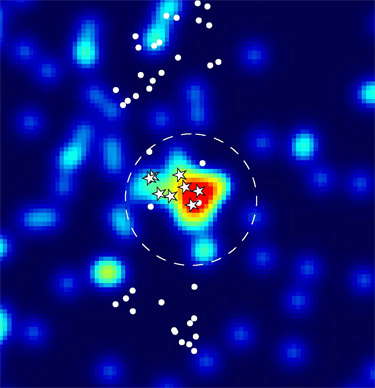 Astronomers have announced the discovery of a Local Group dwarf galaxy, designated Andromeda XII, that formed far out on the edge of the group and is falling into our system for the first time in its history. Jorge Peñarrubia of the University of Victoria made the announcement Monday morning at the American Astronomical Society meeting in Honolulu, representing a team that included Scott C. Chapman of the University of Cambridge and others.
Astronomers have announced the discovery of a Local Group dwarf galaxy, designated Andromeda XII, that formed far out on the edge of the group and is falling into our system for the first time in its history. Jorge Peñarrubia of the University of Victoria made the announcement Monday morning at the American Astronomical Society meeting in Honolulu, representing a team that included Scott C. Chapman of the University of Cambridge and others.
The Local Group of galaxies, our cloud of about 35 objects, includes the Milky Way and giant spirals M31 in Andromeda and M33 in Triangulum. A new discovery in the Local Group is a major event; discovering a pristine dwarf galaxy that can serve as a porthole into the ancient past is a very big deal. "This is a Local Group dwarf that's on its very first infall," says Peñarrubia. "It's the fastest-moving galaxy in the Local Group, moving toward the Andromeda Galaxy at 281 kilometers per second, and the Milky Way at 556 kilometers per second."
Discovered in October 2006 with the MegaCam instrument during a survey with the Canada-France-Hawaii Telescope on Mauna Kea, the galaxy has been nicknamed the "Olympian Galaxy" after the Twelve Olympians in the Greek Pantheon. It is the faintest dwarf galaxy ever found near the Andromeda Galaxy and is thought to have the smallest mass of a dwarf galaxy ever measured. Chapman's measurements of the galaxy show it has an eccentric orbit and lies about 375,000 light-years from the Andromeda Galaxy.
Following the discovery observations, the group used the DEIMOS spectrograph on the Keck II Telescope on Mauna Kea to observe 49 stars in the region of Andromeda XII. Eight were confirmed to be members of the new dwarf galaxy.
The universe is not old enough for Andromeda XII to have formed in the Local Group and be on its second trip through the system. The astronomers feel that Andromeda XII probably formed in a dense, filamentary structure, toward the M81 group of galaxies. It could not have originated in the M81 group, however. It may have formed in a filamentary region of space that connects the Local Group with the M81 group.
Because Andromeda XII has a large amount of dark matter in pristine condition, Peñarrubia says, it will be used as a dark-matter laboratory, and could help to test various dark-matter theories.